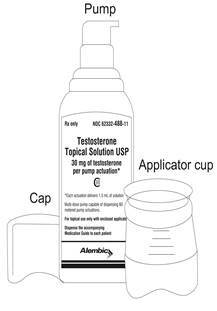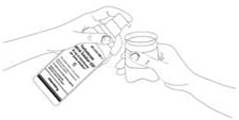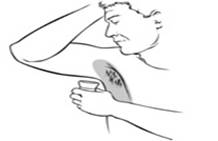TESTOSTERONE
These highlights do not include all the information needed to use TESTOSTERONE TOPICAL SOLUTION safely and effectively. See full prescribing information for TESTOSTERONE TOPICAL SOLUTION. TESTOSTERONE topical solution, for topical use CIII Initial U.S. Approval: 1953
9fe3a833-d9eb-4559-9b9e-1379ec4487a0
HUMAN PRESCRIPTION DRUG LABEL
Dec 8, 2021
Aleor Dermaceuticals Limited
DUNS: 871411532
Products 1
Detailed information about drug products covered under this FDA approval, including NDC codes, dosage forms, ingredients, and administration routes.
TESTOSTERONE
Product Details
FDA regulatory identification and product classification information
FDA Identifiers
Product Classification
Product Specifications
INGREDIENTS (5)
Drug Labeling Information
PACKAGE LABEL.PRINCIPAL DISPLAY PANEL
PACKAGE LABEL.PRINCIPAL DISPLAY PANEL
If the seal is broken before first use, contact your pharmacist.
NDC 71589-013-11
Testosterone Topical Solution USP, 30 mg of testosterone per pump actuation*
CIII
*Each actuation delivers 1.5 mL of solution
Multi-dose pump capable of dispensing 60 metered pump actuations.
For topical use only with enclosed applicator
Dispense the enclosed Medication Guide to each patient
Rx Only
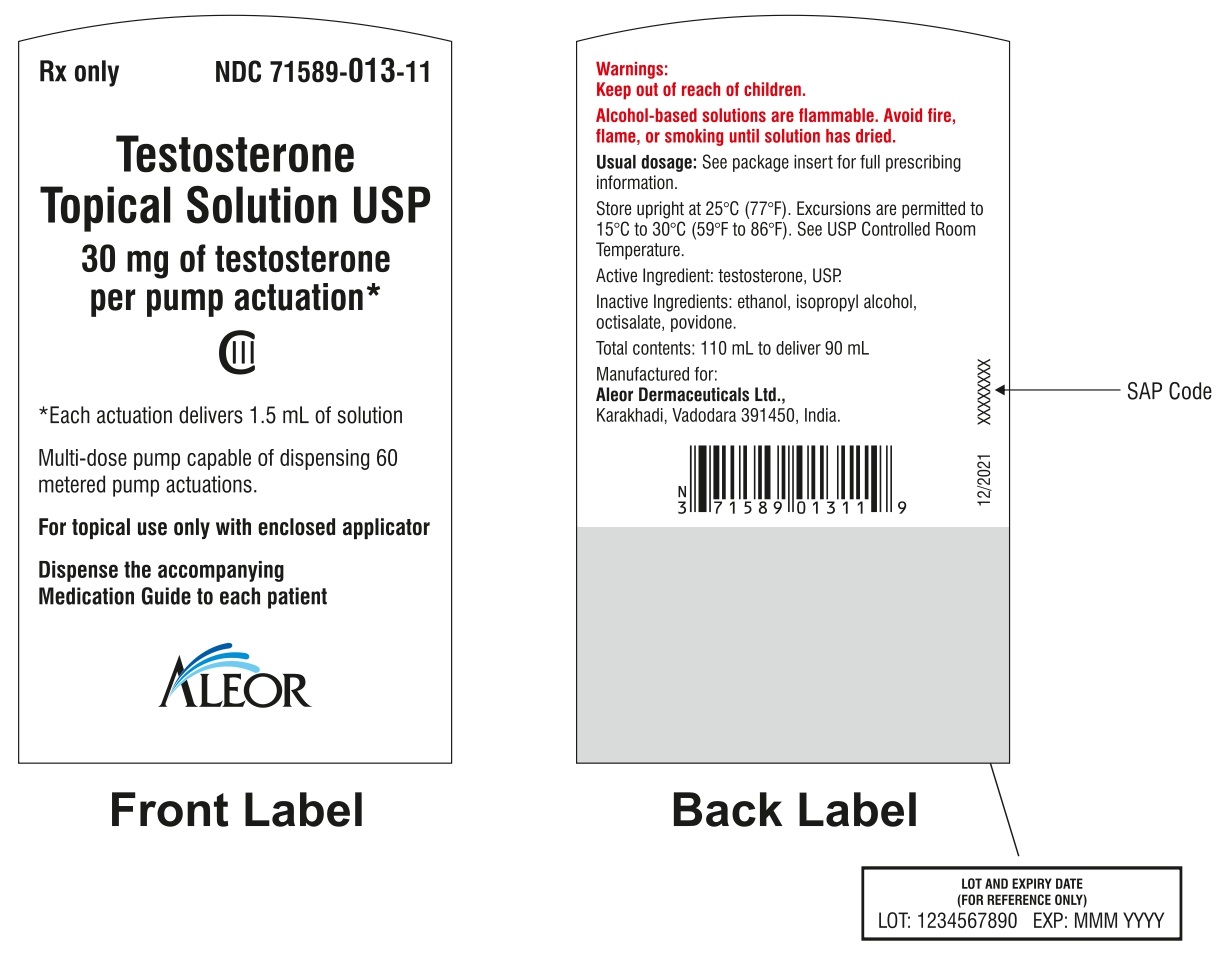
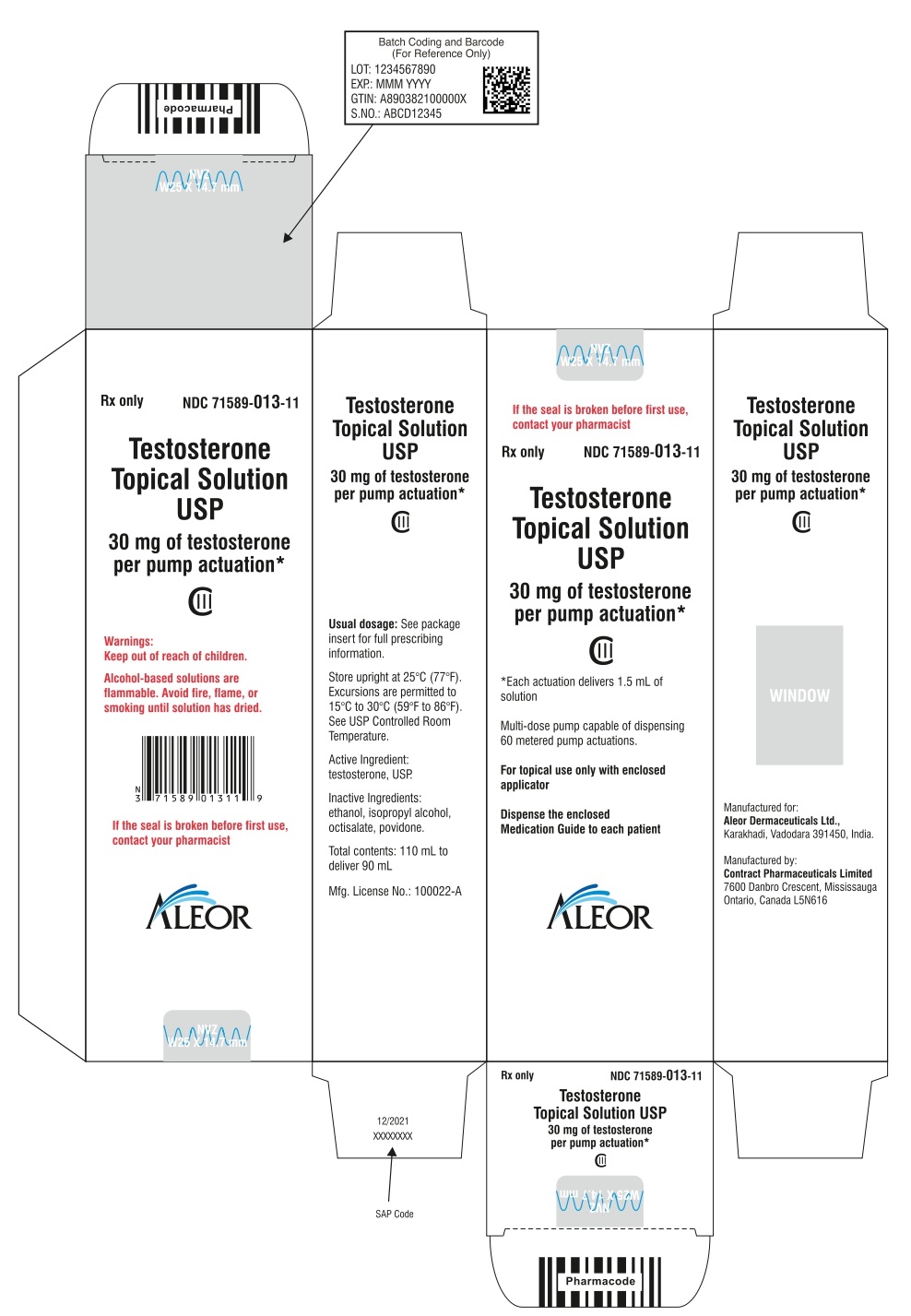
BOXED WARNING SECTION
WARNING: SECONDARY EXPOSURE TO TESTOSTERONE
INDICATIONS & USAGE SECTION
1 INDICATIONS AND USAGE
Testosterone topical solution is indicated for replacement therapy in males for conditions associated with a deficiency or absence of endogenous testosterone.
*Primary hypogonadism (congenital or acquired): testicular failure due to conditions such as cryptorchidism, bilateral torsion, orchitis, vanishing testis syndrome, orchiectomy, Klinefelter's syndrome, chemotherapy, or toxic damage from alcohol or heavy metals. These men usually have low serum testosterone concentrations and gonadotropins (FSH, LH) above the normal range. *Hypogonadotropic hypogonadism (congenital or acquired): gonadotropin or luteinizing hormone-releasing hormone (LHRH) deficiency or pituitary-hypothalamic injury from tumors, trauma, or radiation. These men have low testosterone serum concentrations but have gonadotropins in the normal or low range.
Limitations of use:
- Safety and efficacy of testosterone topical solution in men with "age-related hypogonadism" (also referred to as "late-onset hypogonadism") have not been established.
- Safety and efficacy of testosterone topical solution in males <18 years old have not been established [see Use in Specific Populations (8.4)] .
Testosterone topical solution is indicated for replacement therapy in males for conditions associated with a deficiency or absence of endogenous testosterone:
- Primary hypogonadism (congenital or acquired) (1)
- Hypogonadotropic hypogonadism (congenital or acquired) (1)
Limitations of use:
- Safety and efficacy of testosterone topical solution in men with "age-related hypogonadism" have not been established. (1)
- Safety and efficacy of testosterone topical solution in males <18 years old have not been established. (8.4)
CONTRAINDICATIONS SECTION
4 CONTRAINDICATIONS
- Testosterone topical solution is contraindicated in men with carcinoma of the breast or known or suspected carcinoma of the prostate [see Warnings and Precautions (5.1)].
- Testosterone topical solution is contraindicated in women who are, or who may become pregnant, or who are breastfeeding. Testosterone topical solution may cause fetal harm when administered to a pregnant woman. Testosterone topical solution may cause serious adverse reactions in nursing infants. If a pregnant woman is exposed to testosterone topical solution, she should be apprised of the potential hazard to the fetus. [See Use in Specific Populations (8.1, 8.3)].
- Men with carcinoma of the breast or known or suspected carcinoma of the prostate (4,5.1)
- Pregnant or breastfeeding women. Testosterone may cause fetal harm (4,8.1, 8.3)
ADVERSE REACTIONS SECTION
6 ADVERSE REACTIONS
6.1 Clinical Trial Experience
Because clinical trials are conducted under widely varying conditions, adverse reaction rates observed in the clinical trials of a drug cannot be directly compared to rates in the clinical trials of another drug and may not reflect the rates observed in practice.
Clinical Trials in Hypogonadal Men
Table 2 shows the treatment emergent adverse reactions that were reported by either >4% of 155 patients in a 120 day, Phase 3 study or by >4% of 71 patients who continued to use testosterone topical solution for up to 180 days. These data reflect the experience primarily with a testosterone dose of 60 mg, which was taken by all patients at the start of the study, and was the maintenance dose for 97 patients. However, the doses used varied from 30 mg to 120 mg.
Table 2: Adverse Reactions Seen With the Use of Testosterone Topical Solution in either the 120 Day Clinical Trial or in the Extension to 180 Days (>4%)|
** Event** |
** 120 Days** |
** 180 Days** |
|
Application Site Irritation |
11 (7%) |
6 (8%) |
|
Application Site Erythema |
8 (5%) |
5 (7%) |
|
Headache |
8 (5%) |
4 (6%) |
|
Hematocrit Increased |
6 (4%) |
5 (7%) |
|
Diarrhea |
4 (3%) |
3 (4%) |
|
Vomiting |
4 (3%) |
3 (4%) |
|
PSA Increased |
2 (1%) |
3 (4%) |
Other less common adverse reactions reported by at least 2 patients in the 120 day trial included: application site edema, application site warmth, increased hemoglobin, hypertension, erythema (general), increased blood glucose, acne, nasopharyngitis, anger and anxiety. Other less common adverse reactions reported in fewer than 1% of patients in the 120 day trial included: asthenia, affect lability, folliculitis, increased lacrimation, breast tenderness, increased blood pressure, increased blood testosterone, neoplasm prostate and elevated red blood cell count.
During the 120 day trial one patient discontinued treatment because of affect lability/anger which was considered possibly related to testosterone topical solution administration.
During the 120 day clinical trial there was an increase in mean PSA values of 0.13 ± 0.68 ng/mL from baseline. At the end of the 180 day extension clinical trial, there was an overall increase in mean PSA values of 0.1 ± 0.54 ng/mL.
Following the 120 day study, seventy-one (71) patients entered a two-month extension study with testosterone topical solution. Two patients (3%) had adverse reactions that led to discontinuation of treatment during the period from Day 120 to Day 180. These reactions were: one patient with application site irritation (considered possibly related to testosterone topical solution application) and one patient with dry skin and erythema, but not at the application site (considered not related to testosterone topical solution administration) and application site erythema (considered possibly related to testosterone topical solution administration).
No serious adverse reactions to testosterone topical solution were reported during either the 120 day trial, or the extension to 180 days.
6.2 Postmarketing Experience
The following adverse reactions have been identified during postapproval use of testosterone topical solution. Because these reactions are reported voluntarily from a population of uncertain size, it is not always possible to reliably estimate their frequency or establish a causal relationship to drug exposure.
**Cardiovascular Disorders:**myocardial infarction, stroke [see Warnings and Precautions (5.5)].
**Vascular Disorders:**Venous thromboembolism [see Warnings and Precautions (5.4)].
Most common adverse reactions (incidence >4%) are skin application site reactions, increased hematocrit, headache, diarrhea, vomiting, and increased serum PSA (6.1).
**To report SUSPECTED ADVERSE REACTIONS, contact FDA at 1-800-FDA-1088 or **www.fda.gov/medwatch.
DRUG INTERACTIONS SECTION
7 DRUG INTERACTIONS
7.1 Insulin
Changes in insulin sensitivity or glycemic control may occur in patients treated with androgens. In diabetic patients, the metabolic effects of androgens may decrease blood glucose and, therefore, insulin requirement.
7.2 Oral anticoagulants
Changes in anticoagulant activity may be seen with androgens. More frequent monitoring of INR and prothrombin time is recommended in patients taking anticoagulants, especially at the initiation and termination of androgen therapy.
7.3 Corticosteroids
The concurrent use of testosterone with ACTH or corticosteroids may result in increased fluid retention and should be monitored cautiously, particularly in patients with cardiac, renal or hepatic disease.
- Androgens may decrease blood glucose and insulin requirement in diabetic patients (7.1).
- Changes in anticoagulant activity may be seen with androgens. More frequent monitoring of International Normalized Ratio (INR) and prothrombin time is recommended (7.2).
- Use of testosterone with Adrenocorticotropic Hormone (ACTH) or corticosteroids may result in increased fluid retention. Use with caution, particularly in patients with cardiac, renal, or hepatic disease (7.3).
DOSAGE FORMS & STRENGTHS SECTION
3 DOSAGE FORMS AND STRENGTHS
Testosterone topical solution USP is available as a:
- metered-dose pump that delivers 30 mg of testosterone per pump.
Each metered-dose pump is supplied with an applicator.
Testosterone topical solution is available as follows:
- a metered-dose pump that delivers 30 mg of testosterone per pump.
Each metered-dose pump is supplied with an applicator. (3)
USE IN SPECIFIC POPULATIONS SECTION
8 USE IN SPECIFIC POPULATIONS
8.1 Pregnancy
Pregnancy Category X [see Contraindications (4)] — Testosterone topical solution is contraindicated during pregnancy or in women who may become pregnant. Testosterone is teratogenic and may cause fetal harm. Exposure of a female fetus to androgens may result in varying degrees of virilization. If this drug is used during pregnancy, or if the patient becomes pregnant while taking this drug, the patient should be apprised of the potential hazard to a fetus.
8.3 Nursing Mothers
Although it is not known how much testosterone transfers into human milk, testosterone topical solution is contraindicated in nursing women because of the potential for serious adverse reactions in nursing infants. Testosterone and other androgens may adversely affect lactation. [see Contraindications (4)].
8.4 Pediatric Use
Safety and efficacy of testosterone topical solution has not been established in males <18 years of age. Improper use may result in acceleration of bone age and premature closure of epiphyses.
8.5 Geriatric Use
There have not been sufficient numbers of geriatric patients involved in controlled clinical studies utilizing testosterone topical solution to determine whether efficacy in those over 65 years of age differs from younger patients. Of the 155 patients enrolled in the pivotal clinical study utilizing testosterone topical solution, 21 were over 65 years of age. Additionally, there were insufficient long-term safety data in these patients utilizing testosterone topical solution to assess a potential incremental risk of cardiovascular disease and prostate cancer.
8.6 Renal Impairment
No formal studies were conducted involving patients with renal impairment.
8.7 Hepatic Impairment
No formal studies were conducted involving patients with hepatic impairment.
8.8 Use in Men with Body Mass Index (BMI) >35 kg/m2
Safety and efficacy of testosterone topical solution in males with BMI >35 kg/m2 has not been established.
- There are insufficient long-term safety data in geriatric patients using testosterone topical solution to assess the potential risks of cardiovascular disease and prostate cancer (8.5).
DRUG ABUSE AND DEPENDENCE SECTION
9 DRUG ABUSE AND DEPENDENCE
9.1 Controlled Substance
Testosterone topical solution contains testosterone, a Schedule III controlled substance in the Controlled Substances Act.
9.2 Abuse
Drug abuse is intentional non-therapeutic use of a drug, even once, for its rewarding psychological and physiological effects. Abuse and misuse of testosterone are seen in male and female adults and adolescents. Testosterone, often in combination with other anabolic androgenic steroids (AAS), and not obtained by prescription through a pharmacy, may be abused by athletes and bodybuilders. There have been reports of misuse by men taking higher doses of legally obtained testosterone than prescribed and continuing testosterone despite adverse events or against medical advice.
Abuse-Related Adverse Reactions
Serious adverse reactions have been reported in individuals who abuse anabolic androgenic steroids and include cardiac arrest, myocardial infarction, hypertrophic cardiomyopathy, congestive heart failure, cerebrovascular accident, hepatotoxicity, and serious psychiatric manifestations, including major depression, mania, paranoia, psychosis, delusions, hallucinations, hostility and aggression.
The following adverse reactions have also been reported in men: transient ischemic attacks, convulsions, hypomania, irritability, dyslipidemias, testicular atrophy, subfertility, and infertility.
The following additional adverse reactions have been reported in women: hirsutism, virilization, deepening of voice, clitoral enlargement, breast atrophy, male-pattern baldness, and menstrual irregularities.
The following adverse reactions have been reported in male and female adolescents: premature closure of bony epiphyses with termination of growth, and precocious puberty.
Because these reactions are reported voluntarily from a population of uncertain size and may include abuse of other agents, it is not always possible to reliably estimate their frequency or establish a causal relationship to drug exposure.
9.3 Dependence
Behaviors Associated with Addiction
Continued abuse of testosterone and other anabolic steroids, leading to addiction is characterized by the following behaviors:
- Taking greater dosages than prescribed
- Continued drug use despite medical and social problems due to drug use
- Spending significant time to obtain the drug when supplies of the drug are interrupted
- Giving a higher priority to drug use than other obligations
- Having difficulty in discontinuing the drug despite desires and attempts to do so
- Experiencing withdrawal symptoms upon abrupt discontinuation of use
Physical dependence is characterized by withdrawal symptoms after abrupt drug discontinuation or a significant dose reduction of a drug. Individuals taking supratherapeutic doses of testosterone may experience withdrawal symptoms lasting for weeks or months which include depressed mood, major depression, fatigue, craving, restlessness, irritability, anorexia, insomnia, decreased libido and hypogonadotropic hypogonadism.
Drug dependence in individuals using approved doses of testosterone for approved indications has not been documented.
OVERDOSAGE SECTION
10 OVERDOSAGE
No cases of overdose with testosterone topical solution have been reported in clinical trials. There is one report of acute overdosage by injection of testosterone enanthate: testosterone concentrations of up to 11,400 ng/dL were implicated in a cerebrovascular accident. Treatment of overdosage would consist of discontinuation of testosterone topical solution together with appropriate symptomatic and supportive care.
DESCRIPTION SECTION
11 DESCRIPTION
Testosterone topical solution USP is a clear, colorless, single phase solution containing 30 mg of testosterone in 1.5 mL of testosterone topical solution for topical administration through the axilla. The active pharmacologic ingredient in testosterone topical solution is testosterone. Testosterone, USP is a white to practically white crystalline powder chemically described as 17-beta hydroxyandrost-4-en-3-one. The structural formula is:
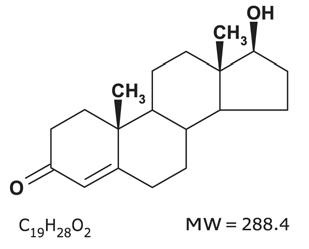
The inactive ingredients are ethanol, isopropyl alcohol, octisalate, and povidone.
CLINICAL PHARMACOLOGY SECTION
12 CLINICAL PHARMACOLOGY
12.1 Mechanism of Action
Endogenous androgens, including testosterone and dihydrotestosterone (DHT), are responsible for the normal growth and development of the male sex organs and for maintenance of secondary sex characteristics. These effects include the growth and maturation of prostate, seminal vesicles, penis and scrotum; the development of male hair distribution, such as facial, pubic, chest and axillary hair; laryngeal enlargement, vocal cord thickening, alterations in body musculature and fat distribution. Testosterone and DHT are necessary for the normal development of secondary sex characteristics.
Male hypogonadism, a clinical syndrome resulting from insufficient secretion of testosterone, has two main etiologies. Primary hypogonadism is caused by defects of the gonads, such as Klinefelter's Syndrome or Leydig cell aplasia, whereas secondary hypogonadism is the failure of the hypothalamus (or pituitary) to produce sufficient gonadotropins (FSH, LH).
12.2 Pharmacodynamics
No specific pharmacodynamic studies were conducted using testosterone topical solution.
12.3 Pharmacokinetics
Absorption — Testosterone topical solution delivers physiologic circulating testosterone that approximate normal concentration range (i.e., 300 to 1050 ng/dL) seen in healthy men following application to the axilla.
On the skin, the ethanol and isopropyl alcohol evaporate leaving testosterone and octisalate. The skin acts as a reservoir from which testosterone is released into the systemic circulation over time (see Figure 1). In general, steady-state serum concentrations are achieved by approximately 14 days of daily dosing.
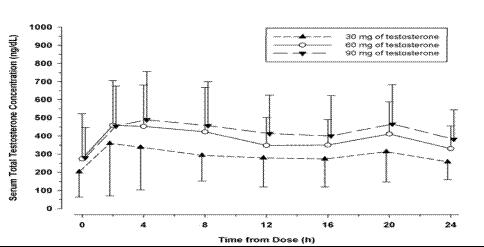
Figure 1: Mean (±SD) Serum Testosterone Concentrations on Day 7 in Patients Following Testosterone Topical Solution Once-Daily Application of 30 mg, 60 mg, or 90 mg of Testosterone
When testosterone topical solution treatment is discontinued after achieving steady-state, serum testosterone concentrations returned to their pretreatment concentrations by 7 to 10 days after the last application.
Distribution — Circulating testosterone is primarily bound in the serum to sex hormone-binding globulin (SHBG) and albumin. Approximately 40% of testosterone in plasma is bound to SHBG, 2% remains unbound (free) and the rest is bound to albumin and other proteins.
Metabolism —Testosterone is metabolized to various 17-keto steroids through two different pathways. The major active metabolites of testosterone are estradiol and dihydrotestosterone (DHT).
DHT concentration increased in parallel with testosterone concentration during testosterone topical solution treatment. The mean steady-state DHT/T ratio remained within normal limits and ranged from 0.17 to 0.26 across all doses on Days 15, 60, and 120.
Excretion — There is considerable variation in the half -life of testosterone as reported in the literature, ranging from 10 to 100 minutes. About 90% of a dose of testosterone given intramuscularly is excreted in the urine as glucuronic and sulfuric acid conjugates of testosterone and its metabolites; about 6% of a dose is excreted in the feces, mostly in the unconjugated form. Inactivation of testosterone occurs primarily in the liver.
Potential for testosterone transfer: The potential for testosterone transfer from males dosed with testosterone topical solution to healthy females was evaluated in a clinical study conducted with a 2% testosterone formulation. 10 males were treated with 60 mg of testosterone in each axilla (the maximum testosterone dose of 120 mg). At 2 hours after the application of testosterone topical solution to the males, the females rubbed their outer forearms for 15 minutes on the axilla of the males. The males had covered the application area with a T-shirt. Serum concentrations of testosterone were monitored in the female subjects for 72 hours after the transfer procedure. Study results show a 13% and 17% increase in testosterone exposure (AUC[0 24]) and maximum testosterone concentration (Cmax), respectively, compared to baseline in these females. In a prior clinical study conducted with a 1% testosterone formulation under similar study conditions, direct skin-to-skin transfer showed a 131% and 297% increase in testosterone exposure (AUC[0-72]) and maximum testosterone concentration (Cmax), respectively, compared to when men had covered the application area with a T-shirt.
In a clinical study conducted with a 2% testosterone formulation to evaluate the effect of washing on the residual amount of testosterone at the axilla, 10 healthy male subjects received 60 mg of testosterone to each axilla (the maximum testosterone dose of 120 mg). Following 5 minutes of drying time, the left axilla was wiped with alcohol towelettes which were assayed for testosterone content. Subjects were required to shower with soap and water 30 minutes after application. The right axilla was then wiped with alcohol towelettes which were assayed for testosterone content. A mean (SD) of 3.1 (2.8) mg of residual testosterone (i.e., 92.6% reduction compared to when axilla was not washed) was recovered after washing this area with soap and water. [see Dosage and Administration (2.2) and Warnings and Precautions (5.2)].
Use of deodorants and anti-perspirants: In a parallel designed clinical study evaluating the effect of deodorants and antiperspirants in healthy premenopausal females dosed with testosterone topical solution, each subject applied either a combined deodorant/antiperspirant spray (6 subjects) or stick (6 subjects) or a deodorant spray (6 subjects) to a single axilla 2 minutes before the application of 30 mg of testosterone to the same axilla. A control group of 6 subjects only applied 30 mg of testosterone to a single axilla. Blood samples were collected for 72 hours from all subjects following testosterone topical solution administration. Although a decrease of up to 33% of testosterone exposure (AUC[0-72]) was observed when antiperspirants or deodorants are used 2 minutes prior to testosterone topical solution application, underarm deodorant or antiperspirant spray or stick products may be used 2 minutes prior to testosterone topical solution application as part of normal, consistent, and daily routine. [see Dosage and Administration (2.2), and Patient Counseling Information (17.4)].
Effect of showering/washing: In a parallel designed clinical study to evaluate the effect of washing on the testosterone systemic exposure, two groups of 6 healthy premenopausal female subjects were each dosed with 30 mg of testosterone to a single axilla. The application sites of each group were washed with soap and water 2 hours or 6 hours after the application of testosterone topical solution. A control group of 6 female subjects applied 30 mg of testosterone to a single axilla and did not wash the application site. Blood samples were collected for 72 hours from all subjects following dosing with testosterone topical solution. A decrease of up to 35% of testosterone exposure (AUC[0-72]) was observed when applications sites were washed 2 hours and 6 hours after testosterone topical solution application. Patients should be advised to avoid swimming or washing the application site until 2 hours following application of testosterone topical solution. [see Dosage and Administration (2.2) and Patient Counseling Information (17.4)].
NONCLINICAL TOXICOLOGY SECTION
13 NONCLINICAL TOXICOLOGY
13.1 Carcinogenesis, Mutagenesis, Impairment of Fertility
Testosterone has been tested by subcutaneous injection and implantation in mice and rats. In mice, the implant induced cervical- uterine tumors, which metastasized in some cases. There is suggestive evidence that injection of testosterone into some strains of female mice increases their susceptibility to hepatoma. Testosterone is also known to increase the number of tumors and decrease the degree of differentiation of chemically induced carcinomas of the liver in rats. Testosterone was negative in the in vitro Ames and in the in vivo mouse micronucleus assays. The administration of exogenous testosterone has been reported to suppress spermatogenesis in the rat, dog and non-human primates, which was reversible on cessation of the treatment.
CLINICAL STUDIES SECTION
14 CLINICAL STUDIES
14.1 Clinical Studies in Hypogonadal Men
Testosterone topical solution was evaluated in a multicenter, open label, 120- day trial that enrolled 155 hypogonadal men at 26 clinical research centers. The median age of subjects was 53 years with a range of 19 to 78 years. Of the 144 subjects whose race was recorded, 122 (84.7%) were Caucasian, 13 (9.0%) were Hispanic, 6 (4.2%) were African Americans, 1 (0.7%) was Asian and 2 (1.4%) had race recorded as "Other".
Patients were instructed to apply testosterone topical solution to unclothed, clean, dry, and unbroken skin. The solution was applied to the axillary area. Patients were not instructed to alter their normal grooming routine, e.g., shave under the arm.
During the initial testosterone topical solution treatment period (Days 1 to 15) 143 patients were treated with 60 mg of testosterone daily. On Day 45 of the trial, patients were maintained at the same dose, or were titrated up or down, based on their 24 hour average serum testosterone concentration measured on Day 15. On Day 90 of the trial, patients were maintained at the same dose, or were titrated up or down, based on their 24 hour average serum testosterone concentration measured on Day 60.
On day 120, 75% of responding patients finished the study on the starting dose of 60 mg of testosterone, while 2% had been titrated to 30 mg, 17% had been titrated to 90 mg and 6% had been titrated to the 120 mg dose.
On day 60, 84.8% of subjects had total testosterone concentrations in the normal range. Of those who had sufficient data for analysis on day 120, 84.1%, had their average serum testosterone concentration in the normal range of 300 to 1050 ng/dL.
Table 3 summarizes the proportion of subjects having average testosterone concentrations within the normal range on Days 60 and 120.
Table 3: Proportion of subjects who had an average Serum Total Testosterone in the range 300 to 1050 ng/dL and completed 120 days of treatment (N=138a)|
** Evaluation Time** |
** Statistics** |
** Value** |
|
Baseline Testosterone |
Mean (SD) |
194.6 ng/dL (92.9 ng/dL) |
|
Day 15 |
Normalb |
76.1%c |
|
95% Cl |
(69.0%, 83.2%) | |
|
Day 60 |
Normalb |
84.8% |
|
95% Cl |
(78.8%, 90.8%) | |
|
Day 120 |
Normalb |
84.1% |
|
95% Cl |
(77.9%, 90.2%) |
a. Three patients who withdrew from the study due to adverse reactions are included as treatment failures.
b. Normal represents the percentage of patients with average testosterone concentration in the range of 300 to1050 ng/dL.
c. On Day 15, 72.2% of the 90 subjects in the US study population had an average serum testosterone in the range of 300 ng/dL to 1050 ng/dL.
Of the 135 patients who completed the 120 day treatment, 123 patients did so with no deviation from the protocol. By day 120, average serum testosterone concentration was within normal range for 67% of those who titrated down on the 30 mg dose, 89% of those on the 60 mg dose, 86% of those who titrated up to 90 mg and 70% of those who titrated up to the 120 mg dose. Table 4 below summarizes the testosterone concentration data in the patients who completed 120 days.
Table 4: Baseline-unadjusted Arithmetic Mean (±SD) Steady-State Serum Testosterone Concentrations on Days 15, 60 and 120 in Patients Who Completed 120 Days of Treatment|
** Dose of Testosterone Topical Solution** | |||||
|
** 30 mg** |
** 60 mg** |
** 90 mg** |
** 120 mg** |
** Overall** | |
|
** Day 15** |
** [N=0]** |
** [N=135]** |
** [N=0]** |
** [N=0]** |
** [N=135]** |
|
Cavg (ng/dL) |
- |
456 (±226) |
- |
- |
456 (±226) |
|
Cmax (ng/dL) |
- |
744 (±502) |
- |
- |
744 (±502) |
|
** Day 60** |
** [N=1]** |
** [N=105]** |
** [N=29]** |
** [N=0]** |
** [N=135]** |
|
Cavg (ng/dL) |
343 (--) |
523 (±207) |
368 (±138) |
- |
488 (±204) |
|
Cmax (ng/dL) |
491 (--) |
898 (±664) |
646 (±382) |
- |
840 (±620) |
|
** Day 120** |
** [N=3]** |
** [N=97]** |
** [N=25]** |
** [N=10]** |
** [N=135]** |
|
Cavg (ng/dL) |
493 (±239) |
506 (±175) |
415 (±165) |
390 (±160) |
480 (±177) |
|
Cmax (ng/dL) |
779 (±416) |
839 (±436) |
664 (±336) |
658 (±353) |
792 (±417) |
Figure 2 summarizes the pharmacokinetic profiles of total testosterone in patients completing 120 days of testosterone topical solution treatment administered as 60 mg of testosterone for the initial 15 days followed by possible titration according to follow-up testosterone measurements.
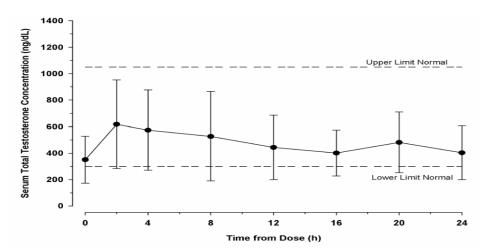
Figure 2: Mean (± SD) Steady-State Serum Testosterone Concentrations on Day 120 (30, 60, 90 or 120 mg testosterone) in Patients Who Completed 120 Days (N=135) of Testosterone Topical Solution Once-Daily Treatment
HOW SUPPLIED SECTION
16 HOW SUPPLIED/STORAGE AND HANDLING
16.1 How Supplied
Testosterone topical solution USP is available as a metered-dose pump containing 110 mL of solution. The pump is capable of dispensing 90 mL of solution in 60 metered pump actuations. One actuation delivers 30 mg of testosterone in 1.5 mL of solution. Each metered-dose pump is supplied with an applicator. The bottle and the applicator cup are not made with natural rubber latex.
|
** NDC** |
** Pump Type** |
|
71589-013-11 |
Pump Actuated |
16.2 Storage and Handling
Keep testosterone topical solution out of reach of children.
Store upright at 25°C (77°F). Excursions are permitted to 15°C to 30°C (59°F to 86°F). See USP Controlled Room Temperature.
Used testosterone topical solution bottles and applicators should be discarded in household trash in a manner that prevents accidental exposure of children or pets.
INFORMATION FOR PATIENTS SECTION
17 PATIENT COUNSELING INFORMATION
See FDA-Approved Medication Guide.
Patients should be informed of the following information:
17.1 Use in Men with Known or Suspected Prostate or Breast Cancer
Men with known or suspected prostate or breast cancer should not use testosterone topical solution. [see Contraindications (4) and Warnings and Precautions (5.1)].
17.2 Potential for Secondary Exposure to Testosterone and Steps to Prevent
Secondary Exposure
Cases of secondary exposure to testosterone in children and women have been reported with topical testosterone products applied to the abdomen, shoulders or upper arms, including cases of secondary exposure resulting in virilization of children, with signs and symptoms including enlargement of the penis or clitoris, premature development of pubic hair, increased erections, aggressive behavior and advanced bone age. Inappropriate changes in genital size or premature development of pubic hair or libido in children, or changes in hair distribution, increase in acne, or other signs of testosterone effects in adult women should be brought to the attention of a physician and the possibility of secondary exposure to testosterone topical solution also should be brought to the attention of a physician. Testosterone topical solution should be promptly discontinued at least until the cause of virilization is identified.
Strict adherence to the following precautions is advised in order to minimize the potential for secondary exposure to testosterone from testosterone topical solution treated skin:
- Testosterone topical solution should only be applied to the axilla, not to any other part of the body.
- Children and women should avoid contact with the unwashed skin of the axilla or unclothed application sites of men where testosterone topical solution has been applied.
- Patients should wash their hands immediately with soap and water after application of testosterone topical solution.
- Patients should cover the axilla application site(s) with clothing (e.g., a shirt) after waiting 3 minutes for the solution to dry.
- Prior to any situation in which direct skin-to-skin contact of the axilla is anticipated, patients should wash the axilla to which testosterone topical solution has been applied thoroughly with soap and water to remove any testosterone residue.
- In the event that unwashed or unclothed skin to which testosterone topical solution has been applied comes in direct contact with the skin of another person, the general area of contact on the other person should be washed with soap and water as soon as possible.
[see Dosage and Administration (2.2), Warnings and Precautions (5.2) and Clinical Pharmacology (12.3)].
17.3 Potential Adverse Reactions with Androgens
Patients should be informed that treatment with Androgens may lead to adverse reactions which include:
- Changes in urinary habits such as increased urination at night, trouble starting your urine stream, passing urine many times during the day, having an urge that you have to go to the bathroom right away, having urine accident, being unable to pass urine and having a weak urine flow.
- Breathing disturbances, including those associated with sleep, or excessive daytime sleepiness.
- Too frequent or persistent erections of the penis.
- Nausea, vomiting, changes in skin color, or ankle swelling.
17.4 Patients Should be Advised of these Application Instructions
- Ensure that the patient understands how to administer the correct dose.
- The pump should be primed by depressing it 3 times prior to its first use. No priming is needed with subsequent uses of that pump.
- Testosterone topical solution should NOT be applied to the scrotum, penis, abdomen, shoulders or upper arms.
- With testosterone doses greater than 60 mg, which require two applications of testosterone topical solution to the same axilla, the product should be allowed to dry after the first application before the second is applied.
- Testosterone topical solution should be applied once daily at approximately the same time each day. Testosterone topical solution should be applied to clean, dry skin.
- Patients may use an antiperspirant or deodorant spray before applying testosterone topical solution. If patients use a stick or roll-on antiperspirant or deodorant, then it should be applied at least 2 minutes prior to application of testosterone topical solution to avoid contamination of the stick or roll-on product.
- Avoid swimming or washing the application site until two hours following application of testosterone topical solution [see Dosage and Administration (2) and Clinical Pharmacology (12.3)].
- Avoid splashing in the eyes. In case of contact with eyes, flush thoroughly with water. If irritation persists, seek medical advice.
- Do not drink testosterone topical solution.
Revised: 12/2021
Manufactured for:
Aleor Dermaceuticals Ltd.,
Karakhadi, Vadodara 391450, India.
Manufactured by:
Contract Pharmaceuticals Limited
7600 Danbro Crescent, Mississauga
Ontario, Canada L5N616
Mfg. License No.: 100022-A
|
** MEDICATION GUIDE** |
|
** What is the most important information I should know about testosterone
topical solution?**
** Behavior problems:**
Women
** Stop using testosterone topical solution and call your healthcare provider
right away if you see any signs and symptoms** in a child or a woman that may
have happened through accidental touching of the area where you have applied
testosterone topical solution:
|
|
** What is**** testosterone topical solution**** ?**
|
|
** Do not use**** testosterone topical solution**** if you:**
Women who are pregnant or who may become pregnant should avoid contact with the area of the skin where testosterone topical solution has been applied. |
|
** Before using**** testosterone topical solution**** , tell your healthcare provider about all of your medical conditions, including if you:**
Tell your healthcare provider about all of the medicines you take, including
prescription and over-the-counter medicines, vitamins, and herbal supplements.
Using testosterone topical solution with other medicines can affect each
other.
|
|
** How should I use**** testosterone topical solution**** ?**
|
|
** What are the possible side effects of**** testosterone topical
solution**** ?** *** If you already have an enlarged prostate, your symptoms can get worse while using**** testosterone topical solution**** .** This can include:
*** Possible increased risk of prostate cancer.** Your healthcare provider should check you for prostate cancer or any other prostate problems before you start and while you use testosterone topical solution. *** Blood clots in the legs or lungs.** Signs and symptoms of a blood clot in your leg can include leg pain, swelling or redness. Signs and symptoms of a blood clot in your lungs can include difficulty breathing or chest pain. *** Possible increased risk of heart attack or stroke.** *** In large doses**** testosterone topical solution**** may lower your sperm count.** *** Swelling of your ankles, feet, or body, with or without heart failure.** *** Enlarged or painful breasts.** *** Have problems breathing while you sleep (sleep apnea).** ** Call your healthcare provider right away if you have any of the serious
side effects listed above.**
** Other side effects include** more erections than are normal for you or
erections that last a long time. |
|
** General information about the safe and effective use of**** testosterone
topical solution**** .** |
|
** What are the ingredients in testosterone topical solution?** |
This Medication Guide has been approved by the U.S. Food and Drug Administration.
Revised: 12/2021
INSTRUCTIONS FOR USE
Testosterone (tes-TOS-te-rone)
topical solution USP, for topical use CIII
Read this Instructions for Use for testosterone topical solution before you start using it and each time you get a refill. There may be new information. This leaflet does not take the place of talking to your healthcare provider about your medical condition or treatment.
Applyingtestosterone topical solution:
*Testosterone topical solutionis to be applied to the armpits only. Do not apply testosterone topical solution to any other parts of your body such as your stomach area (abdomen), penis, scrotum, shoulders or upper arms.
- Do not apply testosterone topical solution with your fingers or hands.
- Apply testosterone topical solution at about the same time each morning. Testosterone topical solution should be applied after showering or bathing.
- Avoid swimming or bathing for at least 2 hours after you apply testosterone topical solution.
- You can use an antiperspirant or deodorant before applying testosterone topical solution. If you use antiperspirant or deodorant, then it should be applied at least 2 minutes before you apply testosterone topical solution. Testosterone topical solution**is flammable until dry. Let*testosterone topical solution** dry before smoking or going near an open flame.** *Avoid splashing in the eyes. In case of contact with eyes, flush thoroughly with water. If irritation persists, seek medical advice.
|
|
Before using a new bottle of testosterone topical solution for the first time, you will need to prime the pump. To prime the testosterone topical solution pump gently push down on the pump 3 times. Do not use any testosterone topical solution that came out while priming. Wash it down the sink to avoid accidental exposure to others. Your testosterone topical solution pump is now ready to use. |
|
** Use testosterone topical solution exactly as your healthcare provider tells you to use it.** Your healthcare provider will tell you the dose of testosterone topical solution that is right for you. Apply your dose correctly by following the application instructions in the table below. |
|
** Find Your Dose as** |
** Each application equals 1 press (depression) of the pump.** |
|
30 mg |
Apply 1 application one time, to one armpit only (left** or** right). |
|
60 mg |
Apply 2 applications: one to the left armpit and then one to the right armpit. |
|
90 mg |
Apply 3 applications: one to the left and one to the right armpit, wait for the product to dry, and then apply again one to the left** or** right armpit. |
|
120 mg |
Apply 4 applications: one to the left and one to the right armpit, wait for the product to dry, and then apply again one to the left** and** one to the right armpit. |
- Before applying testosterone topical solution, make sure that your armpit is clean, dry and that there is no broken skin.
|
|
|
|
|
|
- Let the application site dry completely for 3 minutes before putting on a shirt.
- After you have finished applying testosterone topical solution, rinse the applicator cup with room temperature running water, and then pat it dry with a tissue. Carefully replace the applicator cup and cap back onto the bottle and make sure you store the bottle safely.
- Clean up any spilled solution from surfaces such as the sink or floor to make sure others do not come into contact with it. *Wash your hands with soap and water right away.
How should I storetestosterone topical solution?
- Store testosterone topical solution upright at room temperature between 68°F to 77°F (20°C to 25°C).
- When it is time to throw away the bottle, safely throw away all parts of the testosterone topical solution pump including the bottle applicator cup and cap into the household trash.
- Be careful to prevent accidental exposure of children or pets.
- Keep testosterone topical solution away from fire.
Keeptestosterone topical solution and all medicines out of the reach of children.
This Instructions for Use has been approved by the U.S. Food and Drug Administration.
Revised: 12/2021

